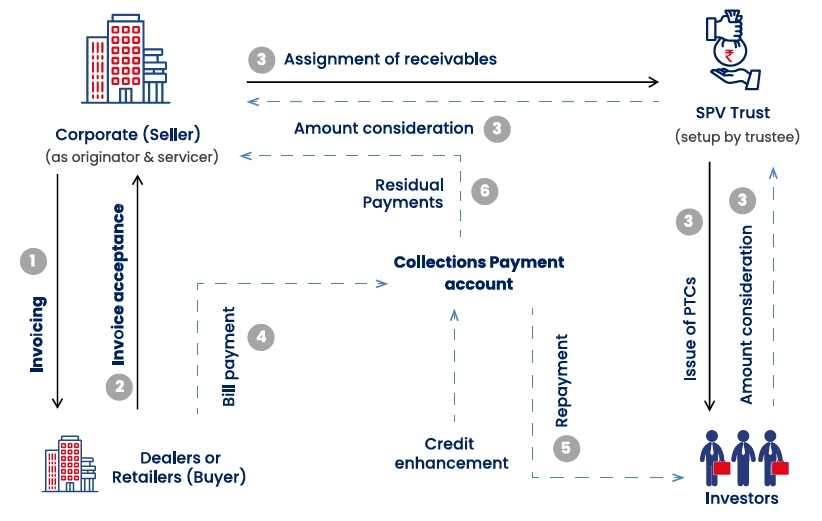Supply Chain Risk Assessment
Risk Management through Rubix’s data and risk analytics

In an increasingly interconnected and volatile world, supply chain risk management has become paramount for businesses seeking to ensure operational continuity and safeguard their bottom line. To this end, the use of risk scoring and credit-limit-setting tools has emerged as a strategic approach for effectively mitigating potential supply chain disruptions. In recent years, third-party platforms offering these services have gained traction, providing businesses with invaluable insights and tools to bolster the strength of their supply chain. Let us look at how risk scoring and credit limit setting help build supply chain resilience.
Assessing supplier risk using risk scoring models
Effective supplier risk management begins with a comprehensive assessment of existing and prospective suppliers. By employing sophisticated Risk Assessment models, businesses can evaluate suppliers and identify their vulnerabilities. These models typically analyse factors such as financial stability, operational track record, management background, legal and compliance risks, and employee and customer feedback and generate risk scores. These risk scores help objectively decide the extent to which a business can rely on its various existing and prospective suppliers and accordingly set credit limits. When scores indicate high risk, a business may either set very low credit limits or terminate the business relationship. When scores indicate lower risk, a business can confidently take a decision to have higher engagement.
Thus, by quantifying risks and assigning scores, companies can sharpen their focus on high-risk suppliers; they can take proactive measures to improve supplier health or find alternative suppliers quickly in order to minimise disruptions to their own supply chain.
Credit limit setting to prevent overexposure to high-risk partners in the distribution chain
Credit limit setting plays a pivotal role in managing financial risks within the distribution chain. It helps prevent credit overexposure to financially unstable customers, distributors and dealers, thus reducing the risk of default resulting from their insolvency or cash flow issues. Setting dynamic credit limits that adjust based on evolving customer, distributor or dealer payment performance ensures ongoing risk mitigation.
A case in point is a leading agrochemical company in India that company deployed the Rubix ARMS™ risk management platform to evaluate the credit risk of each dealer. Its distribution channel was divided into High, Moderate, and Low Risk dealers based on their Rubix Risk Scores, and the credit exposure to each dealer was decided based on its Rubix Risk Score and past payment track record. After rebalancing its overall credit exposure based on this, the company was able to reduce bad debt-write-offs by 25% in 3 years and brought down its Days Sales Outstanding (DSO) by 20 days.
Effective communication and collaboration
Maintaining open lines of communication with suppliers, customers and distributors is essential for managing supply and distribution chain risks. By sharing risk scores with suppliers, customers and distributors, businesses can foster transparency and encourage collaborative efforts towards risk reduction.
Here’s a an example of how this works.
Risk assessment and supplier engagement:
XYZ Corp, which has deployed a supplier credit risk model finds that of its key suppliers, Supplier A, has been assigned a high-risk score, indicating a higher likelihood of delayed payments or default. Recognizing the potential risks associated with Supplier A, XYZ Corp initiates proactive dialogue with the supplier.
Sharing risk scores and concerns:
During the dialogue, XYZ Corp shares with Supplier A, its credit risk score and discusses its concerns about A’s financial stability and potential impact on its own operations. This open communication helps Supplier A understand the shared responsibility in mitigating risks and fosters a collaborative approach.
Joint risk mitigation strategies:
Thereafter, XYZ Corp and Supplier A work together to develop risk mitigation strategies, exploring options such as renegotiating payment terms, implementing regular performance monitoring, and establishing contingency plans in case of supplier disruptions. Thus, by involving Supplier A in the risk mitigation process, XYZ Corp ensures that both parties actively contribute to reducing supply chain risks.
Thus, such proactive dialogue with suppliers about potential risks and concerns creates a sense of shared responsibility, laying the foundation for effective supply chain risk mitigation.
Leveraging third-party platforms
Third-party platforms, such as Rubix ARMSTM, specialising in risk scoring and credit limit setting using Artificial Intelligence (AI) And Machine Learning (ML) offer numerous advantages to businesses that deal with myriad suppliers, customers, distributors, dealers and franchisees. These platforms leverage structured and unstructured data from diverse sources, analytical tools, and industry expertise, to provide valuable, timely risk insights to companies. Using such platforms provides access to a broad range of risk indicators and benchmarks, augmenting the accuracy and reliability of a company’s risk assessments of its counterparties. For example, a leading express courier company in India was able to reduce the default rate of its MSME customers by 33% by deploying the Rubix ARMSTM Platform.
Continuous monitoring and early warning systems
Supply chain and distribution risks are dynamic and subject to constant change. To stay ahead, businesses must adopt a proactive approach to risk management. Continuously monitoring the risk scores and financial health of suppliers, vendors, customers, distributors and dealers is a critical component of supply chain risk management. For example, the Rubix Early Warning System (EWS) The Rubix Early Warning System (EWS) collates key risk indicators on a near real-time basis from various data sources including statutory compliance and financial filings, news, and media to get a dynamic view of a company’s risk profile. It updates the risk score of a supplier, vendor, customer, distributor, or dealer dynamically based on the most updated information. This allows companies to prepare and respond swiftly to changes in the risk scores of counterparties, thus ensuring supply chain resilience.
In sum, in an era characterised by heightened volatility, businesses must prioritise supply and distribution chain risk management to maintain operational continuity and minimise financial losses. Third-party platforms enhance the accuracy, efficiency, and comprehensiveness of risk management efforts. Leveraging these tools and practices empowers businesses to build resilient supply chains.







